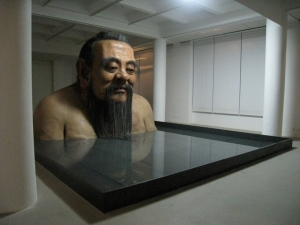Virginia Poundstone plays with mixed media that combines the natural with the unnatural in strange ways. One thing this piece doesn’t show is that this is about counter height which is much more impressive than this image (which makes it seem about palm-sized) belies.
Yuki Ikenobo, in real life, is a headmaster of a holy order of flower arranging. I’m not about to get into all the details about it, but it’s at least five hundred years old, and in a recent interview Ikenobo talked about bringing their arrangements (which are beautiful) to reflect modern tastes. I find this idea perplexingly odd–I mean to me a religious order would create something that wouldn’t cater to human fashion. However, since flower arrangements are always temporary I suppose change is part of their nature. Another thing: Ikenobo means “to bring flowers to life.”
Poundstone’s flower arrangement is NOT temporary–it’s a big print glued to a stone wall. More of the print turns to ribbons on the top, vaguely set in an organic arrangement. What’s interesting is that it has all the trademarks of flower arrangement, with none of the naturalness of one. Aren’t the ribbons in a sort of flower arranging shape? Isn’t the image of flowers? Isn’t this purposely arranged? Why does it look more like a radio than a bouquet?
And what’s striking is this sculpture is just as much “alive” as a flower arrangement—after all, flowers usually are dead, and this is an image of living plants. Yes, I can hear you say, but this isn’t it–this doesn’t bring flowers to life.
And yes, I say, you are right, but isn’t this how many people experience nature? In fact how many people seem to want it to be? Here there will be no rotting, it’s set at a comfortable ratio. It certainly could be useful–I mean the counter could hold things if you like, or be a greeting counter for a bored desk worker at a posh hotel or something. Isn’t it nice and safe, like looking at something through a computer screen? Everything set in very stable looking blocks.
And that’s the thought here–the thought of permanence vs. impermanence. How fickle our idea of beauty is–and how our idea of “natural” vs. “unnatural” is completely imaginary. After all, a bouquet is a completely unnatural arrangement of flowers that looks good because we’ve been taught to expect certain things from a bouquet. Heck, half the time bouquets have flowers that would never grow together.
Wow, Poundstone certainly knows how to pack a concept. This is the art that I like–that which communicates something–and of course Poundstone is not just talking about flower arranging, but the place of all art. What is it for? What’s interesting about both art and humankind is they are the only two things in this universe that has to spend an inordinate amount of time justifying their existences. Why is that?
What I would like to think is that Poundstone read the same article that I did and thought “you want a modern flower arrangement, here’s a modern arrangement for you.”









